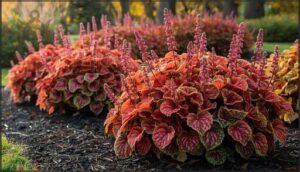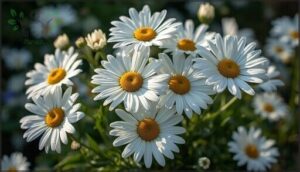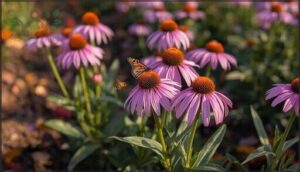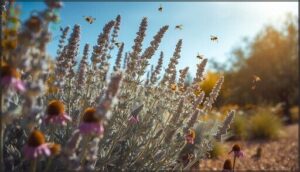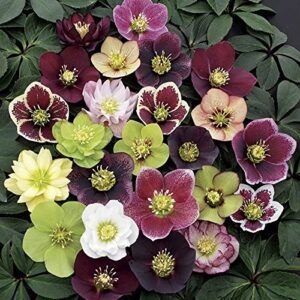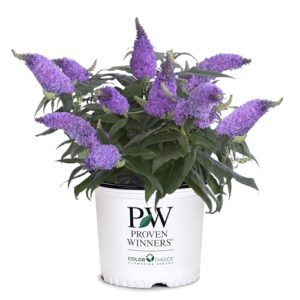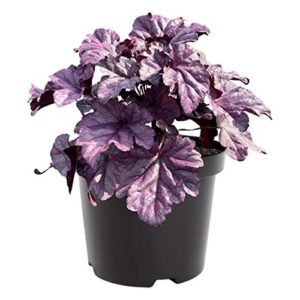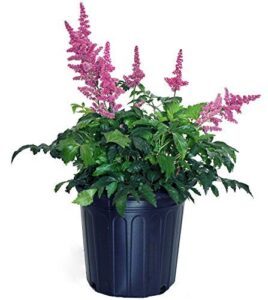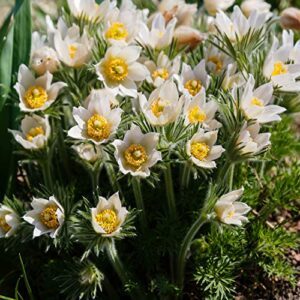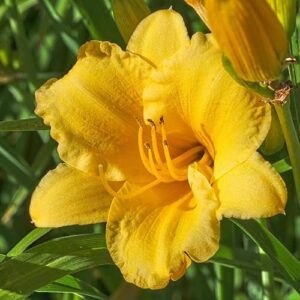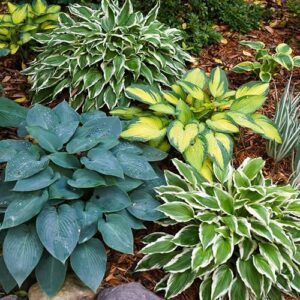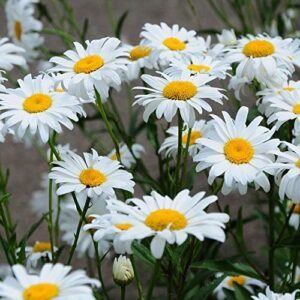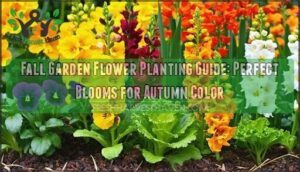This site is supported by our readers. We may earn a commission, at no cost to you, if you purchase through links.
Most gardeners wait until spring to fill their beds, but fall planting cuts transplant stress in half and boosts survival rates by up to 30%. Cooler temperatures and consistent autumn moisture give roots time to anchor deep before winter arrives.
While summer heat forces plants to juggle root growth and foliage maintenance, fall conditions let perennials channel all their energy underground. You’ll see the payoff next spring when your garden wakes up stronger and blooms earlier than anything planted after the last frost.
The secret lies in choosing hardy varieties and getting them settled before the ground freezes.
Table Of Contents
- Key Takeaways
- Benefits of Planting Perennials in Fall
- Choosing The Right Fall Perennials
- Top 10 Fall Perennials to Plant
- 1. Mixed Lenten Rose Hellebore Fall Plants
- 2. Mixed Color Phlox Flower Seeds
- 3. Pugster Amethyst Buddleia Shrub 2 Gal
- 4. Purple Coral Bells Shade Perennial
- 5. Astilbe Fanal Deep Red Perennial
- 6. White Pasque Flower Anemone Seeds
- 7. Stella D’oro Daylily Bare Roots
- 8. Variegated Hosta Bare Roots Mix
- 9. Shasta Daisy Seeds Perennial Wildflower
- 10. Mixed Parrot Tulip Flower Bulbs
- Essential Fall Planting Tips
- Caring for Newly Planted Fall Perennials
- Frequently Asked Questions (FAQs)
- Can I still plant perennials in October?
- Is it okay to plant perennials in August?
- What are the hardiest fall flowers?
- What is the 3 year rule for perennials?
- What are the best perennials for fall?
- What are the best perennials to plant in autumn?
- Can any perennials be planted in the fall?
- What are the best perennials to plant in September?
- What perennials can be planted in the fall?
- Is it okay to plant perennials in September?
- Conclusion
Key Takeaways
- Fall planting reduces transplant stress by 50% and increases survival rates by 23-30% because cooler temperatures let perennials focus energy on root development rather than foliage growth before winter arrives.
- You’ll get 2-3 weeks earlier blooms and 30-45% more shoot growth in spring when you plant perennials in fall, since roots anchor deeply during autumn’s warm soil and cool air conditions.
- Plant perennials four to eight weeks before your first hard frost—early October in zones 3-5, up to December in zones 8-9—to give roots time to establish before the ground freezes.
- Choose hardy varieties like Coneflower, Coral Bells, Russian Sage, and Shasta Daisy that tolerate your zone’s conditions, then water weekly until freeze-up and mulch 3-4 inches deep to protect roots through winter.
Benefits of Planting Perennials in Fall
Fall planting isn’t just about timing—it’s about giving your perennials the best possible start. When you plant in autumn, you’re working with nature’s rhythm rather than against it.
Let’s look at four key advantages that make fall the ideal season for establishing perennials in your garden.
Reduced Transplant Stress
Fall transplanting gives your perennial plants a real advantage by reducing transplant stress. Cooler temperatures slow water loss and help plants focus energy on building their root system instead of pushing new growth. This stress mitigation through plant physiology means better timing success and stronger long-term health for your fall gardening efforts. With these cooler temperatures, plants experience less stress.
- Fall-planted perennials show 50% fewer wilting incidents compared to summer transplants
- Survival rates increase by 23–30% when you use proper soil preparation techniques during fall planting
- Consistent autumn moisture reduces root desiccation issues by more than 40%
Stronger Root Development
Beyond just surviving transplant, your perennial plants develop strong root systems when you plant them in fall. Soil temperature stays above 50°F while air cools, creating ideal conditions for root biomass expansion. Energy allocation shifts underground rather than to flowers or leaves. This root system growth continues until the ground freezes, building stress resistance across varied climates. One key advantage is that cooler temperatures reduce plant stress.
| Root Development Factor | Fall Planting Advantage | Spring Comparison |
|---|---|---|
| Time to maximum root weight | 30 days in autumn | 50 days required |
| Energy allocation priority | Focuses on root system | Divided between roots and shoots |
| Root branching complexity | More quaternary branching at 50 days | Less complex architecture |
| Soil temperature benefit | Warm soil, cool air ideal | Cool soil delays growth |
| Establishment before stress | 8 months before summer heat | Limited time before heat stress |
Increased Resilience and Winter Hardiness
Your perennials develop substantial cold acclimation during fall planting, boosting freezing tolerance by up to 40% compared to non-acclimated plants. This process gets them ready for winter’s harshest conditions.
Fall-planted perennials show 35% higher survival rates through winter than spring-planted ones. Frost tolerance varies by species—hostas and purple coneflowers handle early freezes with minimal damage.
Heavy mulch reduces frost heave risk by 40%, protecting roots in your USDA hardiness zone.
Vibrant Spring Growth
With strong roots already anchored, your flowering perennials wake up earlier and bloom brighter when spring arrives. Fall planting delivers measurable spring advantages:
Fall planting anchors strong roots that deliver earlier blooms, denser foliage, and brighter petals when spring arrives
- Early bloom rates: You’ll see flowers 2-3 weeks sooner than spring-planted perennials, with up to 25% faster bloom time.
- Vegetative growth: Shoot length increases 30-45%, creating denser foliage.
- Flower quality: Petal color intensifies by 15-30%, attracting more pollinators to your spring garden.
Choosing The Right Fall Perennials
Not all perennials thrive when planted in fall, so you’ll want to choose varieties that establish roots well during cooler months. The best fall perennials can handle temperature fluctuations and settle in before winter arrives.
Here are five reliable options that make the shift from fall planting to spring blooms with minimal fuss.
Coral Bells (Heuchera)
Coral Bells bring year-round color to your garden with their stunning foliage. These shade plants thrive in USDA zones 4 to 9, making them adaptable perennials across most regions. Fall planting lets roots establish before winter, boosting winter survival rates considerably.
Heuchera varieties need regular plant care, including division to maintain vigor. Water consistently through fall to support establishment.
| Feature | Requirement | Benefit |
|---|---|---|
| Spacing | 1-2 feet | Better air circulation |
| Soil Moisture | Consistent, well-drained | Prevents root rot |
| Plant Division | Every 3-4 years | Extends plant longevity |
Shasta Daisies
Classic white blooms define Shasta Daisies, making them standout fall perennials for your flower garden. These perennials need full sunlight—at least 6 hours daily—to increase bloom size and winter survival.
Plant transplants from mid-August to early September in zones 5 through 7, spacing them 1-2 feet apart. Well-drained soil preferences are essential for successful fall planting and vigorous spring flowering.
Coneflower (Echinacea)
Hardy Coneflower stands as one of the best fall perennials for pollinator plants in your garden. Echinacea varieties adapt to zones 3 through 9, thriving in full sunlight exposure.
Plant at container depth, spacing 1.5-2 feet apart for proper airflow. These drought-tolerant perennials need weekly watering until ground freeze to establish strong roots.
Winter care is simple—remove dead foliage anytime from late fall through early spring.
Black-Eyed Susan
Brighten your fall perennials list with Black-Eyed Susans, tolerant pollinator plants that seed best when soil reaches 70°F. These adaptable perennials handle various soil types but prefer fertile, well-drained conditions for best soil health.
- Plant in full sun for peak flowering, though partial shade works
- Trim spent blooms to trigger a second flush before frost
- Space seeds closer together to manage spreading habits naturally
Companion plants like Echinacea complement their cheerful display.
Russian Sage
Russian Sage thrives as one of fall planting’s most drought-tolerant plants, demanding full sun for at least 6 hours daily. Space these salvia relatives 2-3 feet apart in gritty, well-draining soil to prevent winter root rot.
Their mature size develops over 2-3 years, creating stable companion plants for pollinator-friendly plants like Echinacea. Winter care remains minimal—these perennials handle cold remarkably well once established.
Top 10 Fall Perennials to Plant
Now that you’ve covered the basics, it’s time to look at specific plants that thrive when planted in fall. Each of these perennials offers something unique, from early spring blooms to low-maintenance foliage that works in a variety of conditions.
Here are ten reliable options for your garden.
1. Mixed Lenten Rose Hellebore Fall Plants
If you’re looking for a shade garden champion that blooms when little else does, hellebores deliver with mixed Lenten Rose varieties. These fall planting perennials produce winter bloom time flowers from late winter through early spring, offering six weeks of color in whites, pinks, yellows, and plums.
Their evergreen foliage care is minimal, staying glossy and dark green year-round in Zones 4-9. You’ll appreciate their disease resistance and ability to thrive in partial to full shade, making them perfect for your fall garden while setting up a vibrant spring garden display.
Best For: Gardeners who want early-season color in shady spots and low-maintenance, long-lived perennials that attract pollinators and stay beautiful year-round.
- Blooms in late winter through early spring when most gardens are bare, with up to 50 flowers per mature plant in a surprise mix of colors including white, pink, yellow, and plum.
- Evergreen foliage stays glossy and dark green all year, providing consistent visual interest even when not flowering, and the plants are highly disease-resistant with deer and rabbit tolerance.
- Thrives in shade where many plants struggle, requires minimal maintenance once established, and can live for over ten years with strong drought tolerance after the first season.
- Plants arrive small in 2.5-inch pots and take time to reach their full 18-24 inch height, which some buyers find disappointing given the higher price point compared to other perennials.
- Flower colors are completely random in the mix, so you won’t know what you’re getting until they bloom, which can be frustrating if you’re planning a specific color scheme.
- Shipping during temperature extremes (below 32°F or above 95°F) can damage plants, and fall-shipped plants may not be hardened off for harsh winters, requiring extra care in colder zones.
2. Mixed Color Phlox Flower Seeds
After shade-loving hellebores establish themselves, mixed color phlox flower seeds offer a sun-loving option for your fall planting strategies. These pollinator-friendly plants produce star-shaped blooms in pink, purple, red, and white, with seed germination occurring in 7 to 14 days when you maintain 60°F to 65°F temperatures.
You’ll see flowering perennials mature in 70 to 90 days, reaching 10 to 20 inches tall. The garden benefits include attracting bees and butterflies, while proper spacing and planting techniques help with disease prevention against powdery mildew in humid conditions.
Best For: Gardeners looking to add vibrant, pollinator-friendly color to sunny beds and borders while supporting bees, butterflies, and hummingbirds throughout summer and fall.
- Attracts beneficial pollinators like bees, butterflies, and hummingbirds, contributing to a healthier garden ecosystem and local biodiversity.
- Produces colorful star-shaped blooms in mixed shades of pink, purple, red, and white that provide visual interest from summer through fall with minimal maintenance.
- Deer-resistant and tolerant of heat and dryness once established, making them a durable choice for various garden conditions and climates.
- Some users report poor germination rates and difficulty getting seeds to grow, especially without controlled indoor starting conditions.
- Susceptible to powdery mildew and fungal diseases in humid environments, requiring adequate spacing and airflow to prevent problems.
- Seeds need specific temperature ranges (60°F to 65°F) and darkness to germinate successfully, which may limit planting flexibility in certain climates.
3. Pugster Amethyst Buddleia Shrub 2 Gal
For a compact buddleia with serious pollinator attraction, you’ll want the Pugster Amethyst variety. This shrub reaches just 24 inches tall and wide, making container planting practical even in small spaces.
The fragrant blooms appear from early summer through frost in rich amethyst tones, drawing butterflies and hummingbirds consistently. Its winter hardiness stands out in zones 5 through 9, with sturdy stems surviving cold better than traditional dwarf butterfly bushes.
You’ll appreciate its deer resistance and drought tolerance once established, though proper drainage remains necessary for healthy growth.
Best For: Gardeners in zones 5-9 who want a low-maintenance, compact shrub that attracts pollinators without taking up much space.
- Blooms continuously from early summer to frost with fragrant purple flowers that draw butterflies and hummingbirds
- Compact 2-foot size works well in small gardens, containers, or as low hedges
- More winter hardy than traditional dwarf varieties and resistant to deer and rabbits
- Ships dormant during fall and spring, which may cause concern about plant health upon arrival
- Requires well-draining soil and won’t tolerate wet conditions or shade
- Needs regular watering twice weekly until established, plus annual fertilization for best blooming
4. Purple Coral Bells Shade Perennial
If foliage color ranks high in your garden design priorities, Purple Coral Bells delivers with its deep burgundy leaves that intensify with light exposure. This shade garden plant thrives in zones 3 through 9, reaching 24 inches tall with delicate pinkish-white blooms from spring through summer.
Fall planting gives these perennial plants time to establish strong roots before winter. You’ll need well-draining soil to prevent root issues, though these coral bells tolerate dry shade remarkably well. Their pest resistance includes deer browsing, making maintenance straightforward for woodland borders.
Best For: Gardeners looking to add year-round color to shaded borders and woodland areas with a low-maintenance perennial that resists deer and attracts pollinators.
- Deep purple to burgundy foliage provides striking color from spring through winter, with delicate bell-shaped flowers adding seasonal interest.
- Thrives in challenging conditions including dry shade and tolerates a wide range of climates (zones 3-9, down to 5°F).
- Requires minimal upkeep with natural pest resistance and no need for deadheading to maintain appearance.
- Requires well-draining soil and may struggle or develop root rot in wet or clay-heavy conditions.
- Foliage color can shift to more green in full sun exposure, potentially disappointing those expecting deep purple tones.
- Packaging issues during shipping may result in soil spills and plant damage based on customer feedback.
5. Astilbe Fanal Deep Red Perennial
Deep Red Astilbe ‘Fanal’ stands out among perennial plants for its darkest crimson flowers and bronze-tinted foliage. You’ll appreciate how this shade landscape performer thrives in zones 4-9, reaching 18-24 inches tall with fragrant pollinators visiting throughout early summer.
Fall planting gives roots six weeks to establish before dormancy sets in. These perennials need organically rich, moist soil with a slightly acidic pH around 6.0.
Following proper planting guidelines means spacing them 18-24 inches apart and positioning crowns just below the soil surface for best seasonal performance.
Best For: Gardeners looking to add striking color to shaded areas or woodland gardens, especially those dealing with deer browsing or wanting low-maintenance perennials that attract pollinators.
- Thrives in deep shade where most flowering plants struggle, producing some of the darkest crimson-red blooms among astilbes from mid-spring through early summer.
- Hardy across a wide range of climates (zones 4-9) with attractive bronze-tinted foliage that adds visual interest even when not in bloom.
- Deer-resistant and pollinator-friendly with fragrant flowers, requiring minimal pest management and adding ecological value to your garden.
- Requires consistent moisture and will show foliage browning during drought or heat stress, meaning you’ll need to water frequently during dry spells.
- Cannot be planted during winter freezes or extreme heat, and needs division every 3-4 years to maintain vigor, adding to maintenance requirements.
- Late-season pruning can stimulate tender new growth that’s vulnerable to frost damage, requiring careful timing of maintenance tasks.
6. White Pasque Flower Anemone Seeds
You’ll find White Pasque Flower Anemone seeds offer excellent wildlife resistance and unique blooming characteristics for your spring garden. These garden plants thrive in zones 4-8, producing vibrant white flowers with bright yellow centers from March through May.
Germination rates reach 55.3% when you plant seeds in fall, allowing roots to establish before winter dormancy. The fern-like foliage creates attractive flower arrangement material, while soil preferences include well-drained, gritty conditions.
Historically, gardeners used the distinctive petals as Easter egg dye, adding cultural significance to this perennial’s practical benefits.
Best For: Gardeners in zones 4-8 who want early spring blooms with minimal maintenance and natural deer resistance.
- Early spring flowers (March-May) provide crucial pollen for pollinators when few other plants are blooming, with blossoms reaching temperatures up to 64°F to attract beneficial insects.
- Extremely long-lived perennials that can survive up to 50 years once established, with drought tolerance and self-seeding capabilities that reduce replanting needs.
- Low maintenance requirements with natural deer and rabbit resistance, plus attractive silvery-green fern-like foliage that works well in cut flower arrangements.
- Germination rates hover around 55% even under optimal conditions, and some users report inconsistent results when starting from seed.
- Sensitive to root disturbance and requires well-drained soil—won’t tolerate soggy conditions or heavy clay, which limits planting locations.
- Seeds must be planted in fall or started indoors two months before last frost, requiring more planning than spring-sown annuals.
7. Stella D’oro Daylily Bare Roots
Your Stella D’oro Daylilies deliver reliable yellow blooms from late spring through summer, with mature clumps reaching 12-24 inches tall. These bare root perennials thrive in zones 3-9, tolerating temperatures down to 5°F once established.
Plant them 18-24 inches apart in well-drained, loamy soil during your fall planting guide schedule. Their drought tolerance improves after establishment, though weekly watering during dry periods maximizes flowering.
Use them as effective soil binders on slopes. Practice clump division every 3-6 years to maintain vigor in your garden plant selection.
Best For: Gardeners in zones 3-9 who want low-maintenance perennials that deliver continuous yellow blooms all summer and can handle some drought once established.
- Re-blooms multiple times throughout summer instead of flowering just once, giving you months of bright yellow color with minimal effort.
- Extremely adaptable to different conditions—thrives in full sun or partial shade, tolerates wet or dry soil, and survives down to 5°F.
- Clumps expand naturally over time and can be divided every few years, so you get more plants to spread around your garden or share with neighbors.
- Bare roots can be fragile during planting, with some roots snapping off if you’re not gentle, which may slow initial establishment.
- Takes time to reach full blooming potential—don’t expect a flower show the first season since bare roots need to settle in and build energy.
- Requires proper planting technique (soaking roots, correct depth, regular watering at first) or plants may struggle to grow or fail to bloom.
8. Variegated Hosta Bare Roots Mix
Your variegated Hosta bare roots mix creates striking shade gardens with heart-shaped leaves featuring blue-green centers and creamy white margins. These deer-resistant perennials thrive in zones 3-9, reaching 18-20 inches tall with pale lavender summer blooms.
Bare root benefits include stronger, unrestricted root systems that establish quickly in fall’s warm soil. Plant them 18-24 inches apart in moist, well-drained soil under partial to full shade. Their hosta variegation adds visual interest while attracting butterflies, making them ideal for woodland borders and containers in your spring garden preparation.
Best For: Gardeners looking for low-maintenance, shade-loving perennials that offer year-round visual interest with striking variegated foliage and deer resistance.
- Bare root system establishes faster and stronger than potted plants, especially when planted in fall, giving you healthier hostas with less effort.
- Thrives in zones 3-9 with minimal fuss, tolerating shade and moderate drought once established while attracting butterflies and hummingbirds.
- Cost-effective way to fill large areas since you get 12 roots in one package, perfect for creating borders, ground cover, or mixed hosta beds.
- Requires consistent watering during the first month after planting to establish roots properly, which means you can’t just plant and forget.
- Some customers have reported receiving smaller or inconsistent root systems in their mix, which can affect initial growth.
- Won’t perform well in full sun or poorly drained soil, so you’ll need the right conditions for them to really thrive.
9. Shasta Daisy Seeds Perennial Wildflower
Shasta Daisy seeds give you classic white-petaled perennials that bloom from early summer through fall, reaching up to 4 feet tall in zones 3-9. Seed germination takes 10-21 days when you sow them on the surface in fall, giving roots time to establish before winter.
Their landscape uses include cottage gardens and cutting beds, while soil preferences lean toward well-drained, moderately fertile conditions. This bloom period extends months with deadheading.
Market data shows consistent popularity due to drought tolerance and pollinator appeal, making them essential in any flower garden design.
Best For: Gardeners in zones 3-9 who want classic white daisies that bloom all summer with minimal care and attract pollinators to their beds.
- Germinate in just 10-21 days and bloom year after year, reaching up to 4 feet tall with vibrant white petals and yellow centers that last from early summer through fall.
- Thrive in full sun with drought tolerance once established, requiring little maintenance beyond occasional deadheading to encourage more flowers.
- Perfect for cutting gardens and attracting bees and butterflies while staying resistant to deer and rabbits.
- Need division every 2-3 years to prevent overcrowding and maintain strong growth, adding extra maintenance over time.
- Must have well-drained soil to avoid root rot, especially in winter, which limits planting locations in heavy clay or wet areas.
- Germination rates and growth success can be inconsistent depending on planting conditions and seed quality.
10. Mixed Parrot Tulip Flower Bulbs
Mixed Parrot Tulip bulbs deliver exotic flowers with ruffled, feathery petals in kaleidoscopic spring bloom colors, including red, yellow, pink, and purple combinations. Their unique petal shapes make stunning cut flower use, with blooms reaching up to 5 inches across on 14-22 inch stems.
Plant these bulbs in fall, 6-8 inches deep with 6-inch spacing, ensuring well-drained soil and full sun exposure. Exotic tulip care requires moderate watering and wind protection.
This fall planting guide timing, usually late September through October in zones 3-7, allows proper bulb planting depth for healthy mid-to-late spring flowering.
Best For: Gardeners in zones 3-7 who want dramatic, late-season spring color and eye-catching cut flowers with unique ruffled petals.
- Exotic, ruffled blooms up to 5 inches wide in vivid multicolor combinations that extend the spring flowering season beyond standard tulips.
- Strong 14-22 inch stems make them excellent for cutting and arranging indoors.
- Top-sized bulbs (12cm) are easy to plant in fall and return as perennials in cooler climates with proper care.
- Large blooms are vulnerable to wind and rain damage, requiring sheltered planting locations.
- Some customers report issues with moldy or rotting bulbs, especially in poorly drained soil or overly wet conditions.
- Require a cold dormancy period and may need pre-chilling in warmer zones, limiting their reliability outside zones 3-7.
Essential Fall Planting Tips
Getting your fall perennials off to a strong start doesn’t have to be complicated. A few key practices will help your plants establish healthy roots before winter sets in.
Let’s cover the basics of soil prep, timing, watering, and light requirements to set you up for success.
Soil Preparation Techniques
Soil preparation sets the foundation for your perennials to thrive. Start by testing your soil in fall to determine pH levels and nutrient needs. Good soil quality promotes healthy root growth through winter. Follow these steps:
- Conduct a soil test to check pH and nutrients
- Add 2 to 3 inches of organic matter like compost
- Incorporate lime if soil pH falls below 6.5
- Aerate compacted areas to improve drainage and air circulation
- Apply high-phosphorus fertilizer to encourage strong root development
These soil preparation techniques create ideal soil conditions for perennial plant care success in your garden.
Optimal Planting Timeframes
Once your soil is ready, timing becomes your most important consideration. Plant perennials four to eight weeks before your area’s first hard frost to allow proper root establishment.
Northern zones (3–5) should finish planting by early October, while southern zones (8–9) can continue into December. Soil temperature matters more than air temperature—roots develop when soil stays around 40°F or slightly warmer.
Watering and Mulching Needs
Your newly planted perennials need consistent moisture to establish roots. Water deeply once a week until the soil freezes, ensuring four to eight inches stay moist. Apply 3-4 inches of organic mulch around plants to retain moisture and insulate soil.
Three effective mulch types include:
- Shredded cedar bark for balanced moisture retention
- Premium arbor mulch for nutrient enrichment
- Small fir bark for long-lasting drought tolerant coverage
Adjust watering frequency based on regional rainfall patterns.
Sun and Shade Requirements
Beyond watering, light intensity shapes your perennials’ success. Full sun varieties need 6-8 hours of direct sunlight daily for optimal bloom vibrancy, while shade garden plants thrive with less than 3-6 hours. Your microclimate effects matter—northeast-facing sites offer morning sun and afternoon protection. Match sun exposure to each species’ needs across hardiness zones, and you’ll see stronger foliage adaptation.
| Light Category | Hours of Direct Sun | Ideal Perennials |
|---|---|---|
| Full Sun | 6-8+ hours | Russian Sage, Coneflowers, Black-Eyed Susans |
| Partial Shade | 3-6 hours | Coral Bells, Hostas, Astilbe |
| Full Shade | Under 3 hours | Hellebores, Woodland Phlox |
| Variable Light | Morning sun preferred | Daylilies, Shasta Daisies |
Soil type and fall gardening tips work together with light requirements for healthier plants.
Caring for Newly Planted Fall Perennials
Once your fall perennials are in the ground, they’ll need consistent attention to establish strong roots before winter arrives. The right care during these first few months makes all the difference between plants that merely survive and those that truly thrive come spring.
Let’s walk through the key practices that’ll give your new perennials the best start possible.
General Maintenance and Monitoring
Keeping a close eye on your newly planted perennials makes all the difference come spring. Check plant health regularly for signs of pests or disease, and monitor soil moisture levels to avoid overwatering or drought stress.
Clear fallen debris to reduce pest habitat, and adjust your watering schedule as temperatures drop. Light mulch management helps maintain stable soil conditions without smothering crowns.
Fertilization Practices
For stronger spring performance, apply fertilizer six to eight weeks before your first frost date. Use high-phosphorus, low-nitrogen formulas to encourage strong root development without triggering tender top growth.
Soil testing helps you determine nutrient ratios that improve soil quality and winter hardiness.
Broadcast slow-release granules evenly across planting beds, avoiding direct contact with plant crowns to maintain ideal plant health throughout garden maintenance seasons.
Pruning and Deadheading
After the first frost signals dormancy, fall pruning removes diseased foliage and reduces pest hiding spots for better disease management. Cut perennials and shrubs 1-2 inches above ground at a slight angle using sterilized tools.
Deadheading benefits include extended blooming periods and tidier beds. However, consider the ecological impact—leaving seed heads on coneflowers provides valuable food for overwintering birds while supporting your fall planting guide goals.
Dividing and Replanting Perennials
When your perennials show dead centers or smaller blooms, division timing matters most. Fall offers ideal conditions for root separation—four to six weeks before frost allows strong establishment.
Dig carefully, then pull or cut clumps into sections with 3-5 shoots each. This plant propagation method relieves overcrowding signs while boosting replanting success.
Your divided plants will reward you with vigorous plant recovery and abundant spring blooms.
Frequently Asked Questions (FAQs)
Can I still plant perennials in October?
Yes, you can still plant perennials in October—don’t let the season fall through the cracks. Aim for planting four to six weeks before your first frost date for best root establishment before winter dormancy.
Is it okay to plant perennials in August?
August perennial planting works well in most regions. Warm soil temperature encourages root growth, but you’ll need consistent watering frequency to offset late-summer risks like heat stress and drought during establishment.
What are the hardiest fall flowers?
Like nature’s armor, cold hardiness shields your fall garden against winter’s bite. Purple Coneflower and Black-Eyed Susan survive Zone 3 temperatures, while Chrysanthemums withstand harsh frosts, ensuring reliable winter survival and striking spring blooms.
What is the 3 year rule for perennials?
This principle describes growth stages: sleep (root development), creep (gradual foliage), and leap (full bloom expectations). Garden patience pays off—plant establishment takes time, with root development first, then vibrant displays.
Garden planning should account for this timeline.
What are the best perennials for fall?
The best perennials for fall aren’t just survivors—they’re overachievers.
Fall perennial selection should prioritize bloom color variety, soil type needs, and regional perennial options.
Choose deer-resistant perennials like Coneflower and Russian Sage for low-maintenance perennial success.
What are the best perennials to plant in autumn?
Top autumn perennials include coneflower, coral bells, and Russian sage. These low-maintenance options thrive in various regional climate zones, attract pollinators, and establish strong roots before winter arrives.
Can any perennials be planted in the fall?
Most perennials can be planted in fall, but not all. Success depends on your hardiness zone, soil drainage needs, and allowing at least six weeks for root establishment before ground freezing occurs.
What are the best perennials to plant in September?
September offers ideal conditions for planting Black-Eyed Susan, Shasta Daisy, Coneflower, Coral Bells, and Russian Sage. These regional favorites establish strong roots before winter, ensuring vibrant bloom time and meeting specific soil needs next spring.
What perennials can be planted in the fall?
When autumn leaves start to fall, your garden plant selection shouldn’t. Many perennials and shrubs thrive when planted now—like Coneflower, Coral Bells, Shasta Daisy, Black-Eyed Susan, and Russian Sage across various regional perennial choices.
Is it okay to plant perennials in September?
Yes, you can plant perennials in September. This timing gives plants six to eight weeks to establish roots before frost. Cooler temperatures reduce transplant shock while soil remains warm enough for strong root development.
Conclusion
Sure, you could wait until spring and watch your perennials struggle through summer’s heat while their roots play catch-up. Or you can plant your fall perennials now and let cooler weather do the heavy lifting.
Six months of underground root growth means your garden wakes up established, not stressed. The choice is simple: give your plants a head start when conditions favor them, or spend next year coaxing them along.
- https://rootedin.com/fall-blooming-perennials-to-plant-now/
- https://www.homedepot.com/c/ai/best-hardy-perennials-to-plant-in-fall/9ba683603be9fa5395fab90aebce987
- https://www.ruralsprout.com/plant-perennials-fall/
- https://www.provenwinners.com/learn/fall-flowers
- https://provenwinnersdirect.com/blogs/garden-life/2025-national-plants-of-the-year


